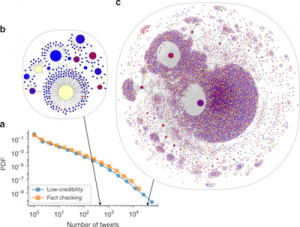
UPDATE: This paper is ranked #3 most read among all articles published by Nature Communications in 2018

Analysis by CNetS researchers of information shared on Twitter during the 2016 U.S. presidential election has found that social bots played a disproportionate role in spreading misinformation online. The study, published in the journal Nature Communications, analyzed 14 million messages and 400,000 articles shared on Twitter between May 2016 and March 2017 -- a period that spans the end of the 2016 presidential primaries and the presidential inauguration on Jan. 20, 2017. Among the findings: A mere 6 percent of Twitter accounts that the study identified as bots were enough to spread 31 percent of the low-credibility information on the network. These accounts were also responsible for 34 percent of all articles shared from low-credibility sources. The study also found that bots played a major role promoting low-credibility content in the first few moments before a story goes viral. The researchers also identified other tactics for spreading misinformation with Twitter bots. These included amplifying a single tweet -- potentially controlled by a human operator -- across hundreds of automated retweets; repeating links in recurring posts; and targeting highly influential accounts. To explore election messages currently shared on Twitter, we also recently launched a tool to measure Bot Electioneering Volume. Created by CNetS Ph.D. students, the program displays the level of bot activity around specific election-related conversations, as well as the topics, user names and hashtags they are currently pushing. More...